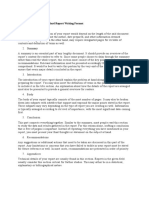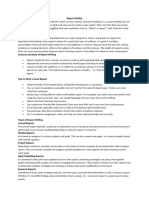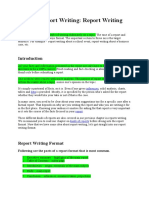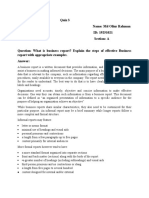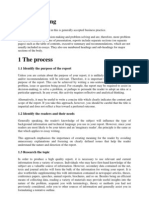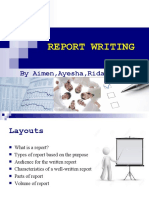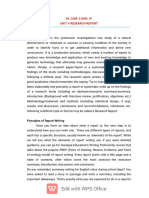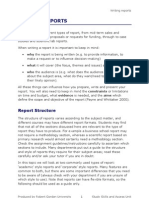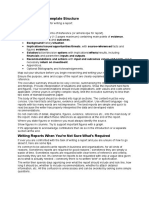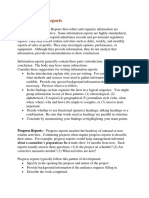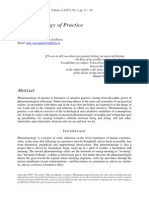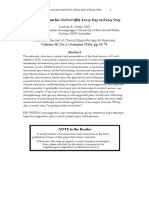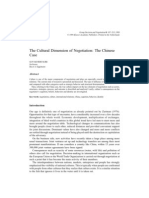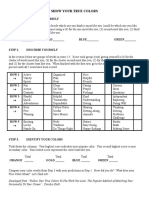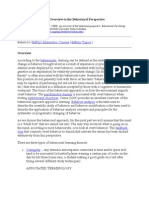Business Report
Business Report
Uploaded by
Ranga ReddyCopyright:
Available Formats
Business Report
Business Report
Uploaded by
Ranga ReddyCopyright
Available Formats
Share this document
Did you find this document useful?
Is this content inappropriate?
Copyright:
Available Formats
Business Report
Business Report
Uploaded by
Ranga ReddyCopyright:
Available Formats
What is a business report?
Business reports are a type of assignment in which you analyze a situation (either a real situation or a case study) and apply business theories to produce a range of suggestions for improvement.
Business reports are typically assigned to enable you to: Examine available and potential solutions to a problem, situation, or issue. Apply business and management theory to a practical situation. Demonstrate your analytical, reasoning, and evaluation skills in identifying and weighing-up possible solutions and outcomes. Reach conclusions about a problem or issue. Provide recommendations for future action. Show concise and clear communication skills.
Remember that with business reports, typically, there is no single correct answer but several solutions, each with their own costs and benefits to an organization. It is these costs and benefits which you need to identify and weigh-up in your report. Further, when writing the report, you need to consider the audience you are writing for: is it the CEO or will the report be available to all staff concerned? It is vital that you ensure an appropriate level of formality, sensitivity, fairness, and objectivity.
Business report structure
Business reports typically adopt the sections listed below. Your assignment question may specify the appropriate sections to use. Introduction: This is the first section of the report and is easiest to write after you have written the other report sections, as then you know what your outcomes will be, which you can briefly summarise in the introduction. The purpose of the introduction is to State the purpose or aim of the report, which may include who has commissioned it, if relevant. Provide background details relevant to the situation, such as a brief overview of historical developments, as well as definitions of any terms that are unlikely to be recognized by the audience. Summarize the problems and recommended solutions. Clarify any limitations, restrictions, and/or assumptions made in undertaking your investigation of the situation, such as restrictions on time, lack of money, limited access to information and people, and/or assumptions made about the organisation because of the lack of information available.
In general, one page is more than adequate to address the issues typically required in an introduction.
Discussion This section is traditionally allocated the most marks, so it is well worth your investment in time to do it thoroughly. The discussion section is generally the only section where you are able to support your analysis and reasoning with theoretical ideas, concepts, and models available within the course. Secondly, it is the only place where you can actually provide evidence to back up your conclusions and recommendations. Therefore, ensure that you draw on evidence from the literature, course materials, as well as your own observations from the actual case or organization, where applicable. A key task of the discussion is for you to be able to identify the problem(s) and then consider a range of possible solutions. Consequently, it may be useful in preparing this section to identify your conclusions and recommendations first, before proceeding to support these outcomes in the discussion. Once you have planned the points you need to cover in your discussion, it is very appropriate to look at creating different sub-sections within the discussion that encompass and frame each of the issues, with meaningful headings for each sub-section. When writing each sub-section within the discussion, the following structure may be useful for demonstrating the process you used to carry out your analysis and evaluation.
Identify the problem Example: The problem involves a lack of coordination at top-level management. Identify the causes Example: This is caused by a lack of organisational skills and a lack of assistance from support people. Identify the symptoms Example: As a result, the department is constantly in a state of flux, with no knowledge of where it should be heading. Identify possible solutions This can be achieved by explaining advantages and disadvantages of a few options, which may involve describing short-term and long-term benefits.
Conclusions This is arranged as a numbered, bulleted-list. Arrange each point in order of importance, rather than necessarily in the order found in your discussion. Match each point in sequence with the list of recommendations. Each point provides a brief summary of one of the problems outlined in detail in the report. Ensure each point links with the report's objectives. Write each conclusion in the present tense. Each point needs to be specific and clear.
Recommendations This is also arranged as a numbered, bulleted-list. Each recommendation should appear in sequence with the order of points in the list of conclusions. Each recommendation should provide a response to each problem identified in the list of conclusions. Each recommendation should be action-oriented, concise, and clear. Each recommendation should also be realistic and feasible within the social, economic, and political climate. Write each recommendation in the future tense, as appropriate.
The order of these sections varies depending on whether it is an inductive or deductive report. Business reports will also need a reference list, and sometimes a covering letter, covering memo, and / or executive summary.
Inductive vs. deductive reports
The order of the report sections will depend on whether you are required to write an inductive or deductive report. Your assignment question should make this clear. Inductive report An inductive report involves moving from the specific issues, as outlined in the discussion, to the more general, summarized information, as displayed in the conclusions and recommendations: Introduction Discussion Conclusions Recommendations Such reports are ideal for an audience who has the time to read the report from cover to cover, and also in instances where the findings may be somewhat controversial, hence, the need to demonstrate your reasoning and evidence, as laid out in the discussion, for the recommendations decided upon. Deductive report In contrast, in a deductive report you move from the general to the specific: Introduction Conclusions Recommendations Discussion This type of order is effective when faced with an audience who does not have time to read the whole document, but can access the conclusions and recommendations. Consequently, such an order is also appropriate for reports which are not contentious or unexpected in their decision outcomes and recommendations.
Business Report Format There are few standard rules for writing business reports that dictate what information should come in which section of the report. This format is followed in most of the business report examples, that one may refer to. The most widely used business report consists of the following standard sections: Title Section: In a short report, this could be the first page bearing the title of the report, author name and date. The reason of making such a report could also be included in this section, so that the reader can establish an instant connection with the information in subsequent sections. In case of long reports, include the Table of Contents, Terms of References and so on. Summary: As the name suggests, this is the summary of the whole report. Then why include it in the beginning of the report itself? It is because this is the section that most of the senior personnel, who do not have enough time to go through the whole report, will read through. Hence, give a very clear and precise information about the problem/aspect of business that the report is analyzing. Also, include the main points, conclusions, recommendations and important results. Although, this section contains a lot of information, ensure that it is a small one. Treat the summary as a separate report and use bullets and numbered lists to highlight important points. Methodology: List the methodologies used in your research, like if you interviewed focus groups or consulted research firms. Also, give the reason why you resorted to using a particular methodology. Introduction: This is the first part of a proper report. Use this section to provide the background of the report. Highlight the reasons why the report is important for the readers. Include information about what is covered in the main body and the order in which the details are covered in the report. In case, the Terms of Reference has not been mentioned in the Title Section, Introduction is the section to include it. Main Body: This is the heart of the report. Arrange all the information in order of priority, so that this section follows a logical sequence. Divide this section further into subsections. Lend greater order to the Main Body using sub-titles within each subsection. A paragraph about the relevance of the findings of the report can also be included in this section. Data Tabulation: Another important factor when writing format of business report is data tabulation. Presenting your data in lists or tables can help in readily understanding the report. Also, data tabulation or listing, makes the report look professional and neat. So, accompany necessary lists or tables in your report whenever required. Make sure you use neutral colors to make tables and keep the list and tables looking neat and crisp. Conclusion: Present logical conclusions for the topic investigated in the report. One can also suggest an option for the way forward. In case, discussion has not been included in the Main Body, include it in the conclusion. Otherwise keep this section small. Recommendations: Since you have worked on the report, no one would have a better understanding of the topic than you. There may be a few solutions or actions that you think would be effective in dealing with the problem, investigated in the report. Include those solutions in this section. List them in bullets and numbered lists for easier comprehension. Appendix: Although very few people read the Appendix, the information in this section gives support to the arguments used in the report. It is the Appendix where the author includes all the sources and research information, in detail.
Although it is not about creative writing, good writing skills are important in business information reports, as one needs to give comprehensive information using precise words. It is advisable to keep the language simple and lucid in a business report, specially in the Summary and the Recommendations, as these are the sections most commonly read by senior level managers. However, some technical jargon can be used in the Main Body, as this is the section that is mostly read by experts. In the world of business, time is money. Following a standard business report format is what senior level managers and busy businessmen look for, as it reflects what they value the most, that is effective utilization of time. You can find many business report format examples online and use them as a reference, to design a suitable report format.
You might also like
- The World of Darkness - Merit's CompendiumDocument284 pagesThe World of Darkness - Merit's CompendiumMatt Litchford90% (31)
- Elias (1994) The Civilizing ProcessDocument293 pagesElias (1994) The Civilizing ProcessAndrei Vladucu100% (3)
- Sample Business Report FormatDocument1 pageSample Business Report FormatmironkoprevNo ratings yet
- Integrated Professional Skills in The Digital AgeDocument7 pagesIntegrated Professional Skills in The Digital AgePaula AndaNo ratings yet
- L7 StudentGuideDocument35 pagesL7 StudentGuidekothanzawoo1979No ratings yet
- Internship Report FormatDocument4 pagesInternship Report FormatShan MalikNo ratings yet
- Report Writing TechniquesDocument6 pagesReport Writing Techniquesyesuplus2No ratings yet
- Commedia Dell'arte - Masters, Lovers and Servants: Subverting The Symbolic OrderDocument6 pagesCommedia Dell'arte - Masters, Lovers and Servants: Subverting The Symbolic Ordersmcgehee100% (1)
- A Business ReportDocument3 pagesA Business ReportRejil Rajan KariyalilNo ratings yet
- Consumer BehaviourDocument61 pagesConsumer BehaviourDILIPKUMAR939No ratings yet
- Request For ProposalsDocument10 pagesRequest For ProposalsKayla MillerNo ratings yet
- Letters Memos and E MailDocument12 pagesLetters Memos and E MailPaul Jordan MalateNo ratings yet
- The Impact of Customer Service Quality On Customer Satisfaction and Loyalty Among Educational Stores in Danao CityDocument59 pagesThe Impact of Customer Service Quality On Customer Satisfaction and Loyalty Among Educational Stores in Danao CitymereanvillenaNo ratings yet
- Brand Management of Apex ShoeDocument28 pagesBrand Management of Apex ShoeMasrur AlveeNo ratings yet
- Applied Nusiness Finance AssignmentDocument13 pagesApplied Nusiness Finance AssignmentHajra HaroonNo ratings yet
- Title Section: Report For Business Main Elements of The Standard Report Writing FormatDocument14 pagesTitle Section: Report For Business Main Elements of The Standard Report Writing FormatSekar Sabina LarasatiNo ratings yet
- Making Formal Business Report: in A Formal Report There Are Three Major SectionsDocument5 pagesMaking Formal Business Report: in A Formal Report There Are Three Major SectionsKristina BankauskaiteNo ratings yet
- DocumentDocument16 pagesDocumentlivinus ochikeNo ratings yet
- What Is The Purpose of An Executive Summary?: Example: The Main Problem Facing Company XYZ Is That Sales AreDocument10 pagesWhat Is The Purpose of An Executive Summary?: Example: The Main Problem Facing Company XYZ Is That Sales ArevincentNo ratings yet
- Executive Summary: Report PurposeDocument5 pagesExecutive Summary: Report PurposeHurmain Khalid100% (2)
- What Is A ReportDocument7 pagesWhat Is A ReportFrances FranciscoNo ratings yet
- Reports Business 2023Document6 pagesReports Business 2023jeramieolinNo ratings yet
- Meaning and Definition of ReportDocument10 pagesMeaning and Definition of ReportNausheen FatimaNo ratings yet
- Writing Technical ReportsDocument5 pagesWriting Technical ReportssmithNo ratings yet
- Report WritingDocument3 pagesReport Writingmdanish63450No ratings yet
- Report WritingDocument6 pagesReport WritingHoney QaisarNo ratings yet
- Q - 4. Enumerate Contents in Report Writing.: Inferences DataDocument4 pagesQ - 4. Enumerate Contents in Report Writing.: Inferences DataAbu MusaNo ratings yet
- Steps in Report Writing-1Document3 pagesSteps in Report Writing-1Mas HudaNo ratings yet
- Week-3 (1)Document20 pagesWeek-3 (1)tasimuddinsohanNo ratings yet
- AssignDocument5 pagesAssignAbdulwedud NuredinNo ratings yet
- How To Write A ReportDocument6 pagesHow To Write A ReportMubashar BashirNo ratings yet
- Assignment On Report Writing 1Document13 pagesAssignment On Report Writing 1Sam SuNo ratings yet
- Quiz 3 Name: MD Oliur Rahman ID: 19251021 Section: ADocument7 pagesQuiz 3 Name: MD Oliur Rahman ID: 19251021 Section: AAsif ZobaedNo ratings yet
- Report WritingDocument30 pagesReport WritingArefin ChyNo ratings yet
- What Reports AreDocument27 pagesWhat Reports AreMohd HafiqNo ratings yet
- How To Write A ReportDocument4 pagesHow To Write A ReportDihartheran RavichandranNo ratings yet
- Report WritingDocument49 pagesReport WritingJahiem GordonNo ratings yet
- Report Writing: 1.1 Identify The Purpose of The ReportDocument8 pagesReport Writing: 1.1 Identify The Purpose of The ReportmkdempsNo ratings yet
- Report Writing: What Is A Report?Document4 pagesReport Writing: What Is A Report?Ali MaherNo ratings yet
- Joint Field Project W 05Document5 pagesJoint Field Project W 05Jazib Ali ShahNo ratings yet
- Report Writing: by Aimen, Ayesha, Rida & HalimaDocument27 pagesReport Writing: by Aimen, Ayesha, Rida & HalimaBushra SyedNo ratings yet
- Research ReportDocument9 pagesResearch Reportrajjj8855No ratings yet
- General Outline For Business Consulting Reports: Management 451Document8 pagesGeneral Outline For Business Consulting Reports: Management 451yasarinuNo ratings yet
- Business Report Writing: Metro Business College Norberto Paranga Jr. ProfessorDocument13 pagesBusiness Report Writing: Metro Business College Norberto Paranga Jr. ProfessorPauleene De VeraNo ratings yet
- Report WritingDocument49 pagesReport WritingValred100% (5)
- Business Report: How To Make A Report & Characteristics of ADocument8 pagesBusiness Report: How To Make A Report & Characteristics of AKunalNo ratings yet
- Unit 5 Lecture NoteDocument6 pagesUnit 5 Lecture NoteJulius EtukeNo ratings yet
- Writing A Case StudyDocument4 pagesWriting A Case StudyJasmine ComayingkingNo ratings yet
- Study Bites - Writing Reports 09-09-2010Document7 pagesStudy Bites - Writing Reports 09-09-2010shanuhiteshNo ratings yet
- Report WritingDocument7 pagesReport WritingSumaya Nimat KhanNo ratings yet
- Report WritingDocument10 pagesReport WritingLiza Ermita AmzarNo ratings yet
- What Is Report Writing?Document7 pagesWhat Is Report Writing?mohsin iqbalNo ratings yet
- Writing Reports - Template StructureDocument4 pagesWriting Reports - Template StructurerekhaNo ratings yet
- Writing ReportsDocument5 pagesWriting ReportsMaricon LagayanNo ratings yet
- Business Report WritingDocument5 pagesBusiness Report WritingBandu SamaranayakeNo ratings yet
- CSG Report Guidelines (1) (3816) FseDocument6 pagesCSG Report Guidelines (1) (3816) FseWaqar HussainNo ratings yet
- Report Structure Report WritingDocument1 pageReport Structure Report WritingC Learning100% (1)
- HandbookDocument5 pagesHandbookRiya ThakurNo ratings yet
- Report Writing-1Document6 pagesReport Writing-1nasreenkumari612No ratings yet
- Report WritingDocument5 pagesReport Writingamra.bsee1166No ratings yet
- LakmeDocument30 pagesLakmedevikaNo ratings yet
- Executive SummaryDocument9 pagesExecutive Summaryvinkumar_hbtiNo ratings yet
- Types of Short ReportsDocument3 pagesTypes of Short ReportsFahad AlbarutNo ratings yet
- Figurative Language LPDocument5 pagesFigurative Language LPChristianNo ratings yet
- Divine Science & New Thought Mailout One MindDocument2 pagesDivine Science & New Thought Mailout One MindElmer GarchitorenaNo ratings yet
- Reviewing K. Popper's Philosophy of ScienceDocument9 pagesReviewing K. Popper's Philosophy of ScienceCatGouveiaNo ratings yet
- The Academy of Management Annals: To Cite This Article: Julie Battilana & Matthew Lee (2014) Advancing ResearchDocument47 pagesThe Academy of Management Annals: To Cite This Article: Julie Battilana & Matthew Lee (2014) Advancing ResearchZelalem GebretsadikNo ratings yet
- The Genius FamineDocument93 pagesThe Genius FamineRoland Czili100% (1)
- HANDMAIDS TALE Study NotesDocument22 pagesHANDMAIDS TALE Study NotesHenry JOhnson100% (2)
- MAPEH 3 Quarter 4 Week 2Document2 pagesMAPEH 3 Quarter 4 Week 2Edlene Joy RemocalNo ratings yet
- Arcilla - 2019 - Ethics and Personal Politics - Agham Tao JournalDocument31 pagesArcilla - 2019 - Ethics and Personal Politics - Agham Tao JournalChester ArcillaNo ratings yet
- IELTS Speaking QuizDocument2 pagesIELTS Speaking Quizndpatel1No ratings yet
- Cox 2015Document18 pagesCox 2015Daniel David MontenegroNo ratings yet
- 3 Simple Secrets To Seduce GirlsDocument33 pages3 Simple Secrets To Seduce GirlsJesperSB SkjærbækNo ratings yet
- Writing CVDocument2 pagesWriting CVbongchuyen89No ratings yet
- 2007 Phenomenology of PracticeDocument17 pages2007 Phenomenology of Practiceiguija6769100% (1)
- Kantian Ethics 02Document22 pagesKantian Ethics 02GINANo ratings yet
- How I Write A ScreenplayDocument16 pagesHow I Write A ScreenplayAnh Vu NguyenNo ratings yet
- Émile Coué and His Method (III) (Yeates, 2016)Document25 pagesÉmile Coué and His Method (III) (Yeates, 2016)rrrrrrrrrrrrrrrrrrrrrrNo ratings yet
- PSTD South Asian TimesDocument1 pagePSTD South Asian TimesfenomenonNo ratings yet
- Are Fingerprint Patterns InheritedDocument5 pagesAre Fingerprint Patterns InheritedShirleyLinNo ratings yet
- Piagets Stages of Cognitive DevelopmentDocument14 pagesPiagets Stages of Cognitive DevelopmentKinneth AguilarNo ratings yet
- 5 Greek MythsDocument2 pages5 Greek Mythsapi-249003537No ratings yet
- BalanceDocument4 pagesBalanceCollenne Kaye-Lie Garcia UyNo ratings yet
- The Cultural Dimensions of NCIDocument30 pagesThe Cultural Dimensions of NCIAura ToaderNo ratings yet
- Show Your True Colors 1 5b1 5dDocument6 pagesShow Your True Colors 1 5b1 5dapi-315994405No ratings yet
- TNA and NTS - TRAINING NEEDS ANALYSIS and NATIONAL TRAINING STRATEGIES - How To Ensure The Right Training at The Right Time To The Right PeopleDocument191 pagesTNA and NTS - TRAINING NEEDS ANALYSIS and NATIONAL TRAINING STRATEGIES - How To Ensure The Right Training at The Right Time To The Right PeopleFyaj RohanNo ratings yet
- An Overview To TheDocument4 pagesAn Overview To Thehope5_fancyfaceNo ratings yet
- Course BookletDocument6 pagesCourse BookletThomas BruceNo ratings yet
- MS-1 Management Functions & BehaviourDocument5 pagesMS-1 Management Functions & Behaviourlist012No ratings yet















